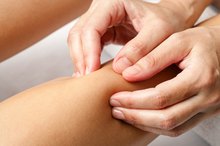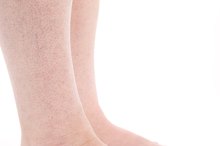What does fact checked mean?
At Healthfully, we strive to deliver objective content that is accurate and up-to-date. Our team periodically reviews articles in order to ensure content quality. The sources cited below consist of evidence from peer-reviewed journals, prominent medical organizations, academic associations, and government data.
The information contained on this site is for informational purposes only, and should not be used as a substitute for the advice of a professional health care provider. Please check with the appropriate physician regarding health questions and concerns. Although we strive to deliver accurate and up-to-date information, no guarantee to that effect is made.
Sciatica & Hamstring Pain
**Sciatica and pain in the hamstring are often confused because of the location of their similar symptoms.
If you are experiencing serious medical symptoms, seek emergency treatment immediately.
** Sciatica is caused when the main nerve in the leg, the sciatic nerve, is irritated or pinched. This will cause pain in the thigh, buttocks and down the leg. There are three hamstring muscles: semitendinosus, semimembranosus and biceps femoris. When one or more of these muscles are torn or pulled, it will cause leg pain.
Facts
Sciatica is a symptom of a bigger problem. Sciatica occurs most commonly in adults between the ages of 30 to 50. It usually occurs when the structure of the lower spine has experienced wear and tear.
Symptoms of sciatica vary from a mild sensation to extreme pain in the lower back and buttocks and down the leg.
It is important to understand the difference between a hamstring injury and sciatic nerve pain. The hamstring muscles are in the back of the thigh while the sciatic nerve travels between the hamstring and buttocks.
- Sciatica is a symptom of a bigger problem.
- The hamstring muscles are in the back of the thigh while the sciatic nerve travels between the hamstring and buttocks.
Function
Iliopsoas Tendon Pain When Walking
Learn More
There are two primary functions of the hamstring muscle; to flex and bend the knee when the leg curls. As the hip performs hypertension the hamstring muscle is used to extend or straighten the hip. Sciatic pain is caused by a muscle called the iliopsoas.
The function of the iliopsoas is to rotate the pelvis so that the sciatic nerve has bone and muscle pressure. The iliopsoas originates from the anterior lumbar vertebrae which pass through the pelvis, into the top-inside of the thigh bone.
- There are two primary functions of the hamstring muscle; to flex and bend the knee when the leg curls.
- The function of the iliopsoas is to rotate the pelvis so that the sciatic nerve has bone and muscle pressure.
Prevention/Solution
Regular hamstring exercises and stretching are the best way to benefit the sciatic nerve. To help prevent sciatica it is important to exercise regularly and maintain proper posture when sitting. A hamstring injury should be treated with an ice pack. An anti-inflammatory and muscle relaxer such as ibuprofen will reduce the swelling in hamstring pain as well as relieve the inflammation.
A daily exercise routine that involves stretching such as yoga will also help to strengthen the hamstring and the sciatic nerve. In more severe cases of sciatica physicians may suggest an epidural steroid injection or surgery.
- Regular hamstring exercises and stretching are the best way to benefit the sciatic nerve.
- A daily exercise routine that involves stretching such as yoga will also help to strengthen the hamstring and the sciatic nerve.
Misconceptions
How to Use a Patellar Tendonitis Strap
Learn More
A hamstring injury and sciatica are often confused. Sciatica originates at the outer side of the thigh, while a hamstring injury occurs in the center of the thigh. When the sciatic nerve is pinched it produces mild to severe pain in the hip, lower pack, buttocks and potentially down to the feet. There are two tests to distinguish between a hamstring injury and sciatica. A hamstring injury is determined by lying on your back with your legs straight and lifting one leg up.
If this is painful it is a hamstring injury. Sciatica is determined if you feel pain when your foot is bent towards your knee.
- A hamstring injury and sciatica are often confused.
- There are two tests to distinguish between a hamstring injury and sciatica.
Warnings
Certain health problems and lifestyle choices can play a big role in developing sciatica or pain in the hamstring 1.
A person with an occupation that requires heavy lifting and long-distance driving has a higher risk to develop sciatica.
People who sit for longer periods of time are more prone to develop sciatica.
People with diabetes are at increased risk for never damage, this condition affects the body’s use of blood sugar. Sciatica typically develops in people over the age of 30.
- Certain health problems and lifestyle choices can play a big role in developing sciatica or pain in the hamstring 1.
- A person with an occupation that requires heavy lifting and long-distance driving has a higher risk to develop sciatica.
Related Articles
References
Writer Bio
Nicole Murray is a full-time freelancer in Chicago, Ill., who has been writing since 2004. She has published articles in "Stone Magazine," ColorsNW.com, "Reservoir Magazine," "Canadian Builders Quarterly" and Blackballot.com. She has her undergraduate degree in creative writing and marketing from Columbia College.








